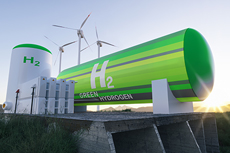
Superglass, a major UK manufacturer of glass mineral wool insulation, has entered into a strategic partnership with Carlton Power to supply it with green hydrogen for its manufacturing facility at Stirling, Scotland. The partnership agreement will support the development of Carlton Power’s proposed Stirling Green Hydrogen scheme and reduce Superglass’ reliance on natural gas.
Superglass, a major UK manufacturer of glass mineral wool insulation, has entered into a strategic partnership with Carlton Power to supply it with green hydrogen for its manufacturing facility at Stirling, Scotland. The partnership agreement will support the development of Carlton Power’s proposed Stirling Green Hydrogen scheme and reduce Superglass’ reliance on natural gas.
The Stirling Green Hydrogen scheme is Carlton Power’s first scheme in Scotland. Subject to planning and final designs, it will be similar to Carlton’s three other hydrogen projects that were shortlisted by the UK Government (March 30th) to receive financial support through the government’s Hydrogen Business Model/Net Zero Hydrogen Fund. The UK Government is using these multi-million-pound programmes to encourage the growth of the hydrogen economy in Scotland and across the UK.
Carlton Power’s Stirling Green Hydrogen scheme will provide Superglass and potentially other energy-intensive users in the area (for example, those with transport fleets) with hydrogen to fuel their operations.
Secured demand for hydrogen at Stirling will underpin the initial development of a 10 MW electrolyser, expected to produce approximately 1000 tpy of green hydrogen - reducing 7000 t of greenhouse gas (GHG) emissions (which is equivalent to taking approximately trucks off Scotland’s roads every year). Carlton Power anticipates hydrogen demand in the area to increase significantly in the near term and will develop the project in such a way that additional capacity can be added. The hydrogen will be produced by an electrolyser using electricity that is generated from sources of renewable energy, primarily wind and solar power.
The scheme is to be located at Polmaise, close to Superglass’ manufacturing plant on the Thistle Industrial Estate in Stirling. The Superglass plant, which completed a £37 million upgrade in 2019, produces around 60 000 t of glass wool insulation annually and employs 200 people.
The scheme, subject to planning and financing, will see sustainable hydrogen fuel being produced at scale, creating opportunities for businesses in Stirling and the surrounding area to make Net Zero plans with hydrogen in mind. The hydrogen hub facility will support the growth of renewable electricity generation by utilising it to produce and store hydrogen at times when renewable output is high, but demand is low.
“We’re delighted to be working with Superglass to bring forward our Stirling Green Hydrogen hub; it will help Superglass achieve its sustainability goals and support Scotland’s decarbonisation strategy. It is critical that projects such as this are brought forward to support investment by local companies in their operations that can reduce their carbon emissions,” said Eric Adams, Hydrogen Projects Director at Carlton Power.
“Carlton Power’s experience in hydrogen and wider energy project development in the UK is first-class, and so we are very pleased to be working with them to develop the Stirling scheme,” added Theresa Mclean, Chief Executive of Superglass.
Over the next 12 – 18 months, Superglass and Carlton Power will work together on the various economic, technical, and engineering aspects of the scheme, as well as consultations with local and national stakeholders, including the Scottish Government.
For more news and technical articles from the global renewable industry, read the latest issue of Energy Global magazine.
Energy Global's Spring 2023 issue
The Spring 2023 issue of Energy Global hosts an array of technical articles focusing on offshore wind, solar technology, energy storage, green hydrogen, waste-to-energy, and more. This issue also features a regional report on commodity challenges facing Asia’s energy transition.